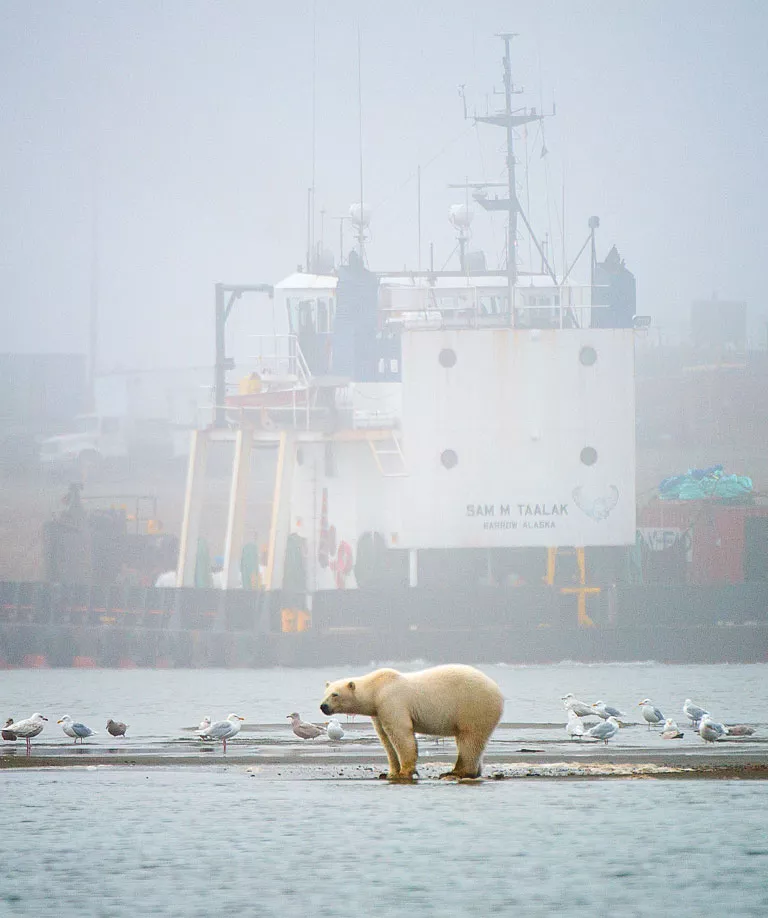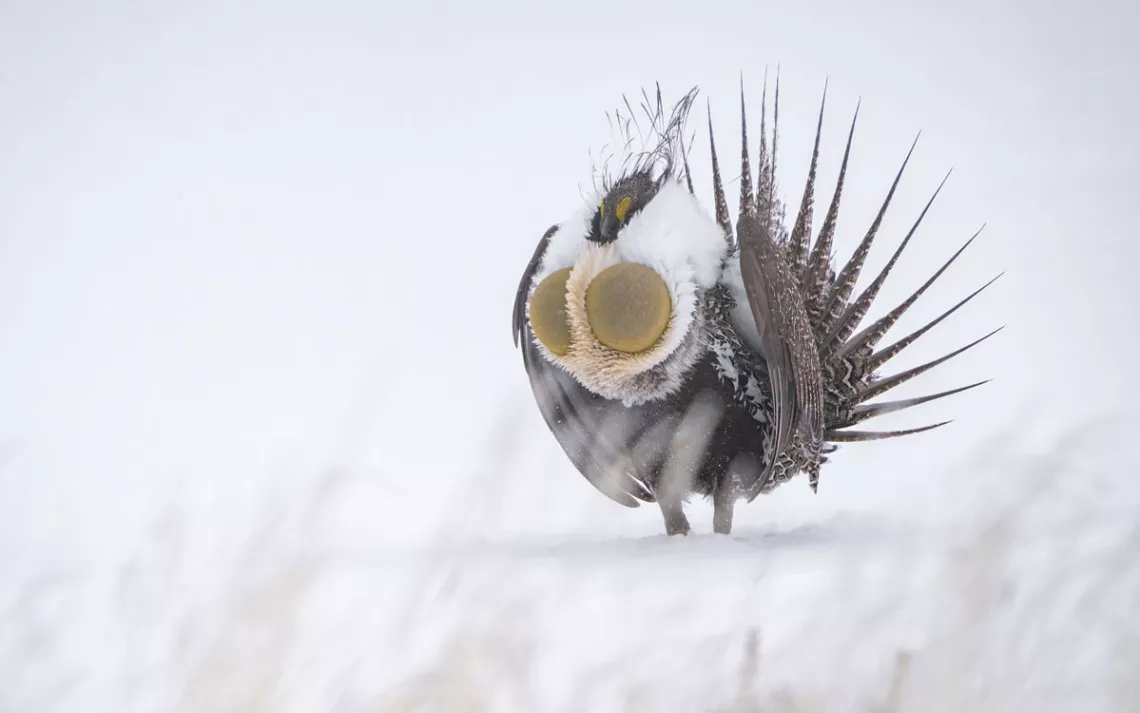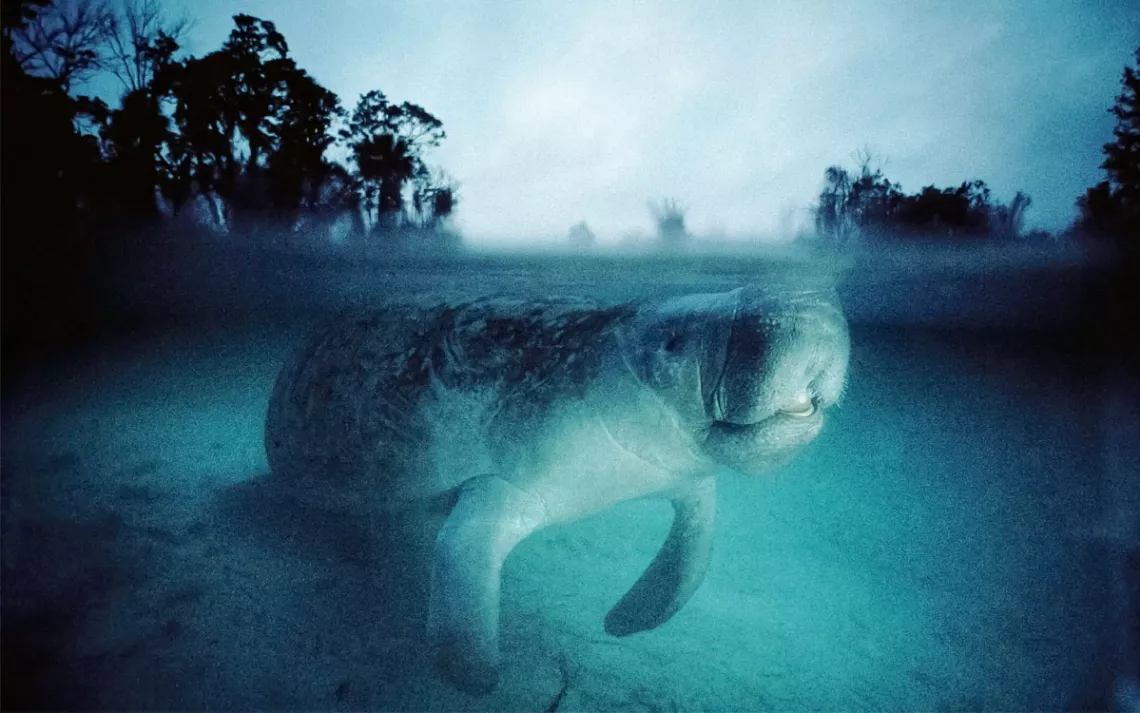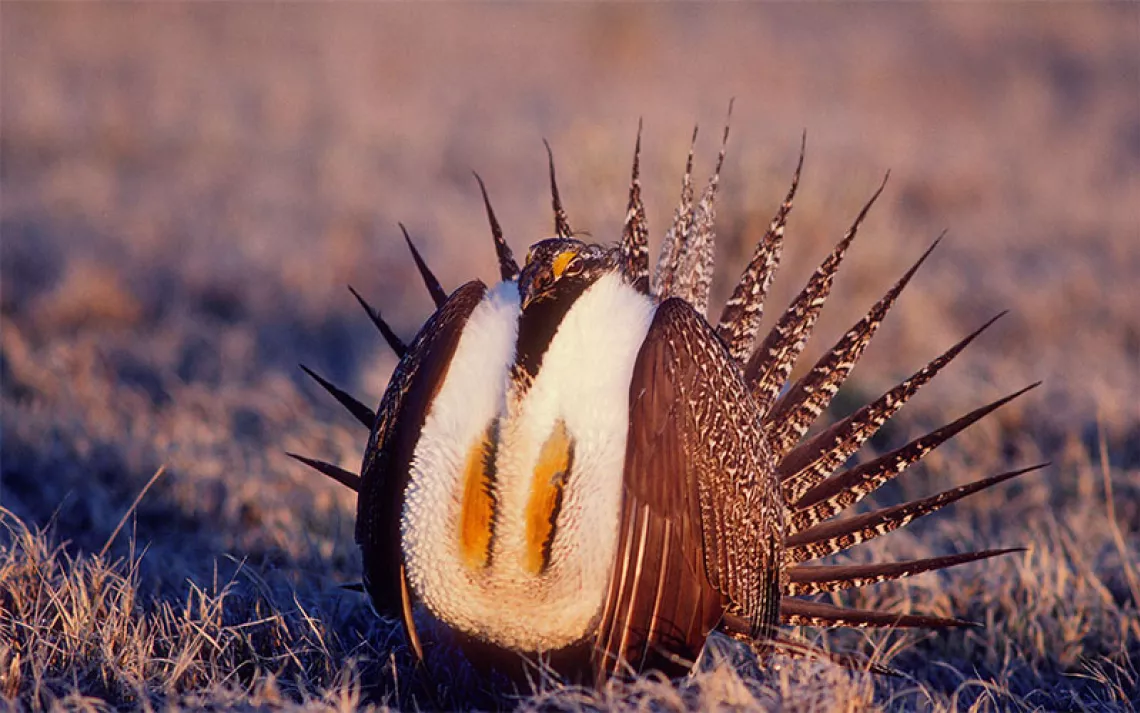How to Make the Endangered Species Act Last the Next 50 Years
What if saving endangered species meant giving up on some of them?

Industrial development and warming Arctic waters continue to reduce the polar bear population. | Photo by Steven Kazlowski
PROTECTING THE NATION'S WILD animals and plants is a bedrock American value. Ever since the Endangered Species Act became law in 1973, public support has remained high. Four out of five Americans—across political ideologies and demographics—favor the ESA. In a national poll from September, 84 percent of respondents backed the law, and 81 percent agreed with the (true) statement that the law has prevented hundreds of species from going extinct.
"If this is the most toxic of political times, and the ESA is still polling this high, that tells me a lot," says Jamie Rappaport Clark, the outgoing president and CEO of Defenders of Wildlife. In the Clinton era, she was the director of the US Fish and Wildlife Service (FWS), which administers the ESA. "The vast majority of the American public love animals and care deeply about nature."

The greater sage grouse has been waiting for protection since 1999; meanwhile, its numbers are crashing. | Photo by Michael Forsberg
And yet, 50 years on, the Endangered Species Act is experiencing a midlife crisis, rooted in the stark misalignment between popular support for the act and opposition from some elected officials. When the ESA was signed by President Richard Nixon, Clark says, it enjoyed "massive bipartisan support" that remained stable for decades. But in the past 10 years, the act has become intensely politicized, with "almost nonexistent Republican support." That might seem strange given the fact that even now, most Republican voters support the ESA. Clark sees Republican politicians' opposition as part of an increasingly "anti-legislation" stance that the party has been taking across a wide range of environmental issues.
Although more species than ever need protection, the inadequate funding from Congress isn't enough to keep them from disappearing—let alone to allow them to recover. Today the ESA is funded at only 40 percent of what it needs to fulfill its promise. Science-based decision-making and the law's mandates are also constantly undermined by attacks from the logging, mining, and oil and gas industries, whose financial interests are jeopardized by wildlife protection. And as climate change turbocharges an already critical situation for conserving these species, at some point in the near future, the ESA might not be able to keep up.
In light of these challenges, says Tim Tear, director of the Center for Climate Change and Conservation at the nonprofit Biodiversity Research Institute, the ESA's 50th anniversary is a good time to do what experts in the field call a "pause and reflect." What have the past five decades taught us about saving species from extinction? How should we strengthen the ESA? And how can we best allocate limited funding?

After thousands of manatees died in 2021 and 2022 from starvation and ship strikes, the FWS is considering restoring their status to endangered. | Photo by Joel Sartore
Our collective answers to these questions, catalyzed through the ballot box, will help to determine the future of one of the most important conservation laws and the species that it's meant to protect. If we fail, the ESA could be diminished to the point that it can no longer perform even its most basic duties. Elected representatives, Clark says, could "completely destroy the regulatory framework that implements the law, or continue to starve it to death."
Yet if voters start electing representatives who take wildlife conservation seriously and hold them accountable for following through on their promises, then the middle-aged ESA could become the forward-looking lifeline for biodiversity that its bipartisan creators intended.
EVEN WITH ITS current challenges, the ESA remains one of the world's most muscular conservation laws. It has grown to include 1,686 domestic species and 698 foreign ones. Ninety-nine percent of listed species have avoided extinction, and high-profile success stories like that of the bald eagle, the American alligator, and the peregrine falcon spotlight the law's potential to fully recover populations.
"It's really hard to think of a single species that isn't threatened by climate change now—including humans—so we're going to need to use every environmental law to address it."
"The ESA does save species from extinction," says Brian Czech, a conservation biologist who spent 17 years at the FWS. "It's built to work."
Lawmakers' presumption when they first drafted the ESA was that saving species would follow a straightforward path: An animal or plant would be listed, and then it would receive help and recover to the point of delisting, freeing up resources for the next species in need. Those original lawmakers also presumed that a suite of upstream solutions—from research-based regulatory interventions to state-led conservation efforts—would lessen both the costs and the number of species in need of saving.
Things have not played out that way. Instead, the ESA has come to shoulder the majority of the burden for preserving the country's biodiversity. And bringing creatures back from the brink has proved to be more difficult than thought. Today at least 80 percent of listed species are considered to be "conservation reliant"—that is, their continued existence depends on ongoing and often costly human intervention.
Take the Oregon silverspot butterfly. The insect depends on mowing and controlled burns to maintain the open coastline habitat that was once naturally kept in check by elk and periodic wildfires. The butterfly's numbers are also propped up by captive rearing and releases, without which the species probably would have already gone extinct in several locations. These efforts are ongoing, with no prospects of an end in sight.
"The problem, really, is that the threats are not removed," says John Wiens, an emeritus ecologist and conservationist at Colorado State University. "And if the threats are not removed, then a species is going to continue to be in trouble."
Despite the inadequate funding to maintain conservation-reliant species and to protect newly listed ones, each year the FWS lowballs the ESA budget request it submits to Congress, according to the Center for Biological Diversity. "It's baffling to me," says Tierra Curry, a senior scientist at the CBD. Her best guess: that the FWS has developed a "culture of timidity."
In response, a FWS representative told Sierra, "The Service's last three annual budget requests have sought increases of 23 percent, 28 percent, and 30 percent over the prior year's enacted funding level for Endangered Species Act implementation. Preventing extinction and recovering listed species is, has always been, and will continue to be, one of the Service's highest priorities."
According to the CBD, Congress responds to the FWS's lowball funding request by giving the agency even less than it asked for. Ultimately, the FWS winds up allocating only 3.5 percent of what's needed for species recovery. Dozens of listed animals and plants receive less than $1,000 per year, and several hundred more receive no money at all.
Freshwater mussels fall in the grossly underfunded category, despite being one of the most endangered groups of animals in the country. More than 70 percent of the approximately 300 US freshwater mussel species are endangered, threatened, or of special concern, primarily due to habitat fragmentation and pollution. But with just a small investment, many mussel species could likely be brought out of the danger zone. Gains in cleaning up previously degraded rivers mean the mussels' habitat can once again support them, but first the mussels need to recolonize these rivers. Researchers have figured out how to grow baby mussels in the lab, so if the FWS would pay for efforts to artificially rear the animals to restore wild populations, multiple species could be taken off the endangered species list.
This would be great, Curry says, because freshwater mussels filter sediment and bacteria out of water, saving cities some of the expense of doing so. They also stabilize stream banks and help build resilient, diverse aquatic communities. Yet, she says, most people "don't even know freshwater mussels exist." Partly as a result of the bivalves' obscurity, the FWS invests virtually nothing into their conservation.
Although every listed species is legally entitled to equal protections, it is usually the charismatic, widely known animals that receive help. The California condor, for example, is one of the most well-known endangered species in the country. It's also one of the most conservation-reliant and heavily funded ESA listees of all. After the species dwindled to just nine individuals in the wild in 1985, conservationists undertook a last-ditch effort to save the birds from extinction through a captive-breeding program. Improbably, it worked, and by 2022, the population of wild condors numbered 347. This victory came at a price tag of more than $50 million, and continued expenditures will be needed to prevent condors from going extinct. Annually, each bird costs the FWS about $5,000 to keep alive.
Condors would not be here if it weren't for these efforts. But it's worth considering, Wiens says, whether the huge amount of money spent on the birds' survival could have been better allocated across a broader array of species. Wiens and some other conservationists are starting to call for a new approach to the ESA, one that invests in fewer species but gives the chosen ones enough resources to have a true shot at recovery. Species would be prioritized for saving based on a set of scientific criteria, including their role in the ecosystem, the degree of peril they face, and the types of threats against them. For those that do not rank high enough, Wiens says, perhaps "you have to let them go on their own." While that may sound harsh, he adds, it's simply not realistic that every species can be saved, especially given the impending threat of climate change.
Many conservationists disagree with this approach. Curry, for example, calls it "completely arrogant" to presume that "we have all the knowledge we need to decide which species are important and which aren't." Bonnie Rice, the Sierra Club's national wildlife campaign manager, says, "We need to practice much more humility, rather than arrogance, in our approach to life on Earth. Every species plays a role within the interconnected web of life. Asserting that we humans have the ability to determine which species to 'let go' is dangerous and shortsighted."
THE FISH AND WILDLIFE SERVICE is not just falling short on its mandate to recover listed species. It's also failing to add species worthy of protections onto the list in a timely manner. For decades, a huge backlog of species that warrant protection have been stuck in decision-making purgatory. The FWS is legally required to make a final listing determination for a species within two years of receiving a petition. But due to a combination of political meddling, lack of resources, and bureaucratic creep, this process takes—on average—10 to 12 years and sometimes much longer.
Conservationists first petitioned for the wolverine to be listed in 1994, for example, and the greater sage grouse in 1999. Both species are still waiting. "I can't stress enough how problematic the delay in listing species is," says Ryan Shannon, a senior attorney at the CBD who is leading a lawsuit against the FWS to expedite decisions on extremely overdue petitions—241 at the time the suit was filed, but now reduced to 94.
FWS officials say they are doing the best they can with limited resources. "We prioritize our listing work, which is limited by a budget that has been flat or declining for over a decade, based on relative risk and urgency, the availability of information, and conservation efforts underway," a FWS spokesperson told Sierra.
Delays in listing only make species' recoveries more expensive and difficult. When conservationists first petitioned in 1998 to get the Sacramento Mountains checkerspot butterfly listed as endangered, a small population of the insect remained. But opposition from the local cattle association caused years of delay, and by the time the FWS declared the butterfly endangered in January 2023, biologists could find only 23 surviving adults. This butterfly is just one of many examples of what some conservationists call "ghost species"—ones that have been reduced to such low numbers that they no longer play a meaningful role in the environment and have poor prospects for recovery. "They're kind of doomed anyway at that stage," Czech says.
Political meddling can also influence whether the FWS decides to list a species as endangered or threatened. A listing of "threatened" used to confer virtually all the same protections as "endangered." But then the Trump administration changed the rules, leaving it up to the FWS to set protections for threatened species on a case-by-case basis. The Biden administration has moved to overturn those changes, and they are expected to be reversed by the end of 2023. That doesn't guarantee, though, that science will suddenly prevail in all ESA-related decision-making, which has been bogged down in political and industry interference for years.
Numbers of the northern long-eared bat, for example, have declined by 97 percent since 2007. In 2015, the FWS classified the species as threatened rather than endangered—and with a special carve-out to exclude habitat protection. This meant industries engaged in land clearing would not have to mitigate their activities even if northern long-eared bats lived there. This wasn't for lack of evidence that the bat should be listed as endangered or that protecting its habitat was not critical for its survival. Instead, these decisions were made because of broad opposition from the fracking, mining, and forest industries. "When listings go to Washington for final approvals, that's where they're watered down or overturned," Curry says. "It's no longer based on science at all; it's just straight-up political interference." The CBD challenged the bat's threatened status in court and finally secured an endangered classification, which went into effect in early 2023.
The same type of industry meddling is holding up the listing of dozens of other species, including manatees, monarch butterflies, and lesser prairie chickens. Removing science from conservation decision-making is like putting your head in the sand, Clark says: If you ignore the reality of a species' situation, "you're not going to get a different response."
Political interference also hampers other laws that are supposed to provide measures to stop species from reaching the point of crisis in the first place, including the Clean Water Act, the National Environmental Policy Act, the Migratory Bird Treaty Act, and the Marine Mammal Protection Act. When state and federal environmental laws fall short, it puts more pressure on the ESA to swoop in and save the day. "I look at the ESA as a tool of last resort, but it's now taking much more of a center stage than is appropriate," Clark says. "It's having to take on way more responsibility than it should or that it's funded to do."
LONG-SUFFERING ESA-listed species are also subject to what Curry calls "death by a thousand cuts." One of the law's hallmarks is its requirement that key habitats be protected for listed species. But this rule is regularly bent or simply ignored. Take the state forests of coastal Oregon, home to threatened northern spotted owls. Logging has reduced much of the formerly sprawling ecosystem to sparse patches of trees—those containing owl nests—surrounded by barren, clearcut wastelands.
Similar stories abound. In March, the Biden administration approved a huge Alaska oil-drilling project called Willow, located in the largest single expanse of wildland in the United States. The administration green-lighted the project despite the "substantial concerns" for wildlife outlined in the Department of the Interior's environmental impact assessment, including for ESA-listed species such as polar bears, ringed seals, and bearded seals.
For endangered animals, conservation groups and their lawyers can and do challenge cases that involve destruction of species or their habitats. But for endangered plants, there's much less they can do. ESA-listed plants that grow on private land receive no meaningful protections unless there's federal funding or permitting attached to whatever activity or project is behind the taking. In Kentucky, the Louisville Gas & Electric company has plans to destroy the habitat of threatened Kentucky glade cress—a member of the mustard family with delicate white and yellow flowers—to install a gas pipeline that would cut across private farms and protected conservation lands. Even though Kentucky glade cress is listed under the ESA, "these populations aren't protected" because it's a plant, Curry says. "There are hundreds, if not thousands, of examples like this across the country."
Also among the listed-but-not-protected are hundreds of foreign species. The idea of listing them is to ensure that Americans don't contribute to further declines of endangered species abroad. But, as with domestic species, ESA-listed foreign species are undercut by limited protections. Thanks to Reagan-era undermining of the law, the US government and military and federally funded US companies can destroy endangered species' habitats abroad without prior consultation with the FWS. When the Reagan administration made this change in 1986, it provided "absolutely no explanation," says senior attorney Sarah Uhlemann, director of the CBD's international program. "They just did it."
Conservation groups have challenged this engineered loophole several times in court but without success. In 2012 and 2013, the CBD brought a case against the Export-Import Bank of the United States for violating the ESA by loaning nearly $4.8 billion to finance two liquefied gas projects on the Great Barrier Reef. Despite the location being a UNESCO World Heritage Site that is home to ESA-listed loggerhead sea turtles, green sea turtles, and dugongs, the judge overseeing the case dismissed it for lack of standing. "We continue to look for the right case," Uhlemann says. In the meantime, projects led and funded by the US around the world chip away at the ecosystems upon which endangered species depend.
THERE ARE straightforward ways to make the ESA more effective. Allocate more money for its administration and hire more FWS biologists. Accelerate the listing process. Let science, not politics, guide decision-making. Conserve species with upstream solutions early, before they've been reduced to critical levels. Protect habitats and fully implement other environmental laws. Hold violators accountable.
Even if the ESA were perfectly executed, though, it would be hard-pressed to address the magnitude of the biodiversity crisis. Global wildlife populations have declined by 69 percent since 1970, and more than 1 million species face extinction. In the United States, 40 percent of animal species, 34 percent of plant species, and 41 percent of ecosystems are at risk of collapse.
According to research conducted in 2023 by Defenders of Wildlife, climate change now poses the greatest threat to species in the US. (Worldwide, habitat loss still ranks first.) Solving the climate crisis is well beyond the scope of the ESA; the increasing numbers of imperiled species listed as a result of it only add to the cacophony of alarms about the need to take political action on the issue. "It's really hard to think of a single species that isn't threatened by climate change now—including humans—so we're going to need to use every environmental law to address it," Curry says.
Given the scale of impending threats, more action will be needed. In September, the CBD, the Sierra Club, and 280 other nonprofit organizations sent a letter to President Biden urging him to initiate a whole-of-government approach to not only saving and recovering endangered species but also rebuilding biodiversity. Working toward this goal, lawmakers could pass the Recovering America's Wildlife Act, which would provide $1.3 billion in annual funding by 2026 for conserving more than 12,000 species in need of assistance. In 2022, Congress couldn't agree on how the law would be paid for, and the bill failed. It was reintroduced in 2023, but new House rules put in place by Republicans will make the question of payment all the more difficult to resolve.
Some proposed actions are broader in scale. Delegates at a 2021 meeting of the International Union for Conservation of Nature called for protecting half the earth's lands and seas by 2030. Another approach is the call for a paradigm shift toward a "steady state economy"—one that is neither growing nor receding, says Czech, who founded the nonprofit Center for the Advancement of the Steady State Economy to promote the issue. A third avenue is the international movement to grant legal standing to nature, a concept famously articulated by Supreme Court justice William O. Douglas in his dissent in the 1972 case Sierra Club v. Morton.
Some of these proposals may sound radical or pie in the sky, but business as usual is not saving humans or other species. "So goes nature, so goes us," Clark says. "That challenge is becoming more obvious as the years go by. The sustainability of nature is what ultimately sustains all of us."
Regarding the ESA and what it is intended for, there is some good news—and there is still hope. Most endangered species in the US remain intact, albeit in small populations, and we can still turn their situations around. Americans can take a simple action to make that happen: Vote for candidates who share our commitment. It's up to us to prioritize these issues at the ballot box and to convince others to do the same.
"Species are generally quite resilient if given the chance," Clark reminds us. "With adequate funding and political support, we can solve the biodiversity crisis."
This article has been updated since publication.
 The Magazine of The Sierra Club
The Magazine of The Sierra Club



